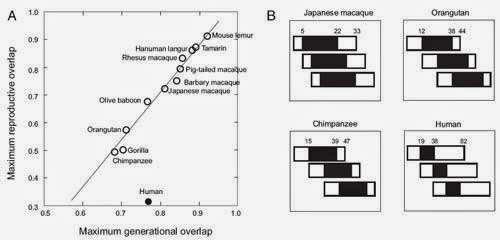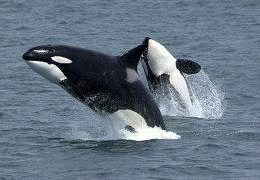Previous studies have allowed for the current picture to be
incomplete, according to Cant and Johnstone, as they have disregarded the fact
that it is not only the mothers that are affected by new offspring, but other
members of the community too. In any group of fertile women, the offspring draw
upon the same resources, nourishment and attention from other adults, which leads
to a form of “reproductive rivalry” between mothers.
Menopause is proposed, by Cant and Johnstone, to assist towards
minimising this conflict as well as to cite the timing of menopause as evidence
for their theory. Within humans, different generations show minimal overlap
between reproductive periods, while in hunter-gatherer civilizations, the
mothers fertility tends to cease at more or less the same time as their
daughters reach sexual maturity.
Amongst other primates, this degree of separation is extraordinary,
which, as the graph below shows, most offspring develop fertility while their
mothers are still more than capable of conceiving. For example, roughly 12
years of Japanese macaque’s fertility periods overlap, which is around 70% of
their total reproductive lifespan. Based on the trends presented by other
primates, human women would be expected to keep on reproducing till the age of
70, rather than the earlier cut-offs in their 50s.
Figure 1. Reproductive overlap in humans and other primates. (A) Maximum reproductive versus maximum generational overlap in 12primate species recently classed as exhibiting a post reproductive life span (24). (B) Pattern of overlap for these four species. R.A. Johnstone & M.A. Cant (2008).
From birth, a woman contains a lifetime supply of follicles (envelopes
of cells that contain immature eggs; Derry, 2006) which gradually lessen as menstrual
cycles occur, however this process accelerates powerfully
around the age of 38, in a way that doesn’t happen in chimps, monkeys or
rodents (Cant and Johnstone, 2008). If this acceleration never evolved,
menopause would occur around the age of 70 due to the earlier and slower rate
of follicle loss, which is predicted by trends in other primates of the same
age.
References:
Brenner, R.M., & Slayden, O.D. (2012). Molecular and
functional aspects of menstruation in the macaque. 10.1007/s11154-012-9225-5.
Derry, P.S. (2006). A Lifespan biological theory of
menopause. Sex Roles. 54, 393-399.
Johnstone, R.A., & Cant,
M.A. (2008). Reproductive conflict and the separation of reproductive
generations in humans, 105(14):5332-5336. Doi:10.1073/;pnas.0711911105.
Johnstone, R.A., & Cant,
M.A. (2010). The evolution of menopause in cetaceans and humans: the role of
demography, 277(1701):3765-3771. Doi: 10.1098/rspb.2010.0988.





